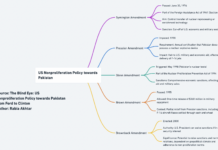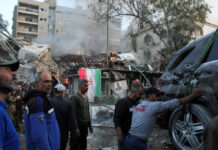Mariam Shah
Since October 7, 2023, the Middle East has seen a surge in conflicts and geopolitical tensions. The Israel-Hamas conflict, in which a series of subsequent incidents have intensified, has not only caused devastating impacts on the ground but also brought the entire Middle East to the edge of a broader war. This conflict has rippled across various regions as many states and non-state actors, western nations, and allies have now been involved, including Yemen, Iran, Hezbollah, the U.S. U.K., and others. The terrorist attack in Kerman, Iran, Houthis targeting ships in the Red Sea, and escalation between Hezbollah and Israel speak to the web of complexities in the region. The corollary of all this is that the ongoing spell of conflict between Hamas and Israel has engendered further instability in the Middle East. This is evidenced by tensions between Tel Aviv and Hezbollah in Lebanon, not to mention a series of assassinations.
Meanwhile, the Red Sea became a ‘red zone’ as the Houthis targeted ships and cargo vessels destined for Israel. Recently, the U.S., UK, and allies started bombing Yemen without any authorization from the United Nations Security Council (UNSC) to use force against that country. During a UNSC emergency conference on the Red Sea situation, China’s Permanent Representative to the UN, Zhang Jun, emphasized that the UNSC had never sanctioned any nation to employ force against Yemen. He highlighted that the military actions carried out by the involved countries directly contradicted the recently adopted UN Resolution 2722, underscoring the inconsistency in the Security Council’s decisions.
Such is the volatility in the region that whenever there is an escalation, there is always speculation about potential responses from key regional players. After recent speeches from its Secretary-General, Hassan Nasrallah, Hezbollah has escalated its rhetoric and action in response to current events, which might drag Lebanon into a wider regional conflict. One aspect that is very critical at this juncture is that the region can get more entrenched in proxy wars and a cycle of retaliatory strikes. However, one cannot overlook advanced weaponry, including precision-guided, that raises serious risk, with a single significant military action having the potential of triggering widespread reactions and ramifications. We recently witnessed high-profile killings of Hezbollah members and a commander by Israeli strikes. The situation has raised fears of an expanded conflict between Israel and Iran. Recent events, including the killing of an Iranian Revolutionary Guard figure by an Israeli airstrike and attacks in the Red Sea, attributed to Iran-aligned forces, have heightened tensions. There is a growing concern that a confrontation could ensue if any U.S. warship is targeted. All this has contributed to exacerbating instability.
The United States’ response to the situation has been marked by continuing traditional strategies : pitching money, weapons, and military assets at the region. The Biden administration is again doing what the U.S. has been doing in the Middle East for the past many decades: military interventions, unconditional support to its allies, and failing to address the root causes of conflicts. Interestingly, U.S. Secretary of State has made at least five trips to the region since the war on Gaza began, engaging in shuttle diplomacy, with none bringing any respite for Palestinians under bombardment, not least because there is no pressure exerted on Israel for a ceasefire.
One also cannot ignore the underlying political motivations of Benjamin Netanyahu and Joe Biden, as their political situations are influencing their handling of the conflict. U.S. election is due later this year, and the Biden administration seems to be making politically motivated decisions, taking aggressive stands to garner local support, and inadvertently escalating tensions. The situation is further complicated by internal dynamics within Israel, particularly with Prime Minister Netanyahu facing criticism for security lapses. His political standing seems intertwined with the course of these conflicts, adding a volatile element to an already risky situation.
The war in Gaza, a focal point of the recent turmoil, has not only caused immense human suffering and displacement but also exposed the image of the Western ‘liberal democracy’ due to its support for actions that contradict propagated values related to human rights and dignity. Focused on causing maximum damage, Israel’s military strategy has also raised concerns about the indiscriminate killing of civilians.
Consequently, it seems that a prolonged conflict has erupted between Hamas and Israel in Gaza, sparking broader regional turmoil that might engulf additional Palestinian territories and the reoccupation of Gaza. The situation in the West Bank has also been volatile. According to the Spokesman of the United Nations International Children’s Emergency Fund (UNICEF), Jonathan Crick, “violence has reached unprecedented levels [in the West Bank].” During the past many weeks, nearly “Eighty-five Palestinian children have been killed” due to increased military and law enforcement operations by Israeli forces.
Moreover, the death toll stands at a staggering 25,000 Palestinians. Taking account of this vast number of civilians killed by Israel, South Africa submitted an application to institute proceedings against Israel under the Genocide Convention. On January 11, in the International Court of Justice (ICJ) hearing, South Africa accused Israel of committing a state-led genocide campaign against the Palestinian population by submitting supporting evidence. The Israeli government has acknowledged the Court’s legitimacy in presenting its case and will find it challenging to dismiss an adverse verdict. Additionally, if genocide is deemed probable, it would greatly stigmatize a country established as a refuge from such atrocities, intensifying pressure on Netanyahu to halt actions and, ultimately, making it more challenging for the U.S. to continue its unconditional arms support.
It would, therefore, be reasonable to say the Middle East is on the precipice, with aggressive rhetoric, geopolitical moves, and looming military actions raising fears of a broader regional conflict. Hence, it is time for nations to reevaluate their diplomatic ties and push for diplomatic initiatives. The events of October 7 proved to be yet another watershed for the Middle East given that they led to the intensification of violence in the region. Therefore, if stakeholders do not identify and use off-ramps, this bevy of conflicts will become extremely difficult to terminate and resolve.
Mariam Shah is an independent researcher and a PhD scholar of peace and conflict studies.
The views expressed in this article are the author’s own and do not necessarily reflect those of Pakistan Politico.

















